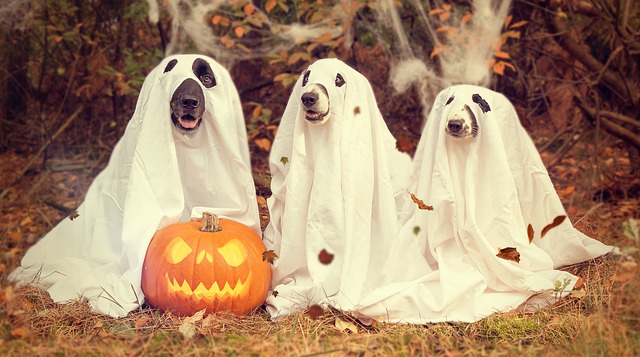Main Content
Halloween Safety Tips

By: FUN Monster
Every year, millions of kids and teens wait for the holiday of fun and frolic when they can dress up in spooky costumes, express their unique brand of creativity, and bag a bunch of candy while doing it: Halloween! But while the holiday can open up fantastical worlds, it can also present challenges for kids who want to stay safe and sound. Countless injuries, illnesses, and accidents take place on Oct. 31, but the odds of getting hurt can be decreased when you take a few common-sense precautions when trick-or-treating, choosing costumes, and eating treats. With the right precautions, even pets can safely enjoy the holiday!
Trick-or-Treating
- Map out your trick-or-treating route before going out so that you won't get lost. Tell adults where you'll be going in case they need to find you.
- Only approach houses that are well-lit and inviting: Homeowners who don't celebrate Halloween and aren't interested in handing out candy may not have cleared their yards and made their property safe for visitors.
- Practice the buddy system by trick-or-treating with a group of friends. Trust your instincts: Only enter the homes of adults you know, and don't get into strangers' vehicles.
- Avoid walking on wet sidewalks, stepping on damp leaves, or walking through muddy areas, as these hazards can make you slip and fall.
- Don't enter dark and dangerous areas like alleyways, abandoned buildings, or dilapidated houses.
- Charge your cell phone before you go, and carry an extra battery pack. Make sure you can easily access it in case of an emergency. Avoid using your cell phone while walking down streets or around moving vehicles.
- Stay alert and respect the rules of the road: Cross streets using crosswalks, look for oncoming cars before moving between houses, don't run, use sidewalks, and always face traffic when walking so that drivers can see you.
Costume Safety
- Find ways to make your presence known under the moonlight: Consider wearing neon colors, carrying a flashlight, adding reflective tape to your clothes or bag, or wearing a glow stick around your neck.
- When shopping for costumes, look at tags and labels to find one that is made out of flame-resistant material.
- Choose an outfit that isn't too loose, tight, stiff, or long. Refrain from costumes that require you to wear items around your neck that can catch on things around you.
- Opt for face paint instead of masks. When shopping for makeup, buy from trusted brands, and look for labels that indicate that the products are nontoxic.
- Wear comfortable walking shoes, like sneakers, with your costume so that you can walk long distances without tripping or falling.
Food Safety/Allergies
- Don't accept perishable items as treats.
- If you attend parties, avoid drinking unpasteurized juice and cider to reduce the chances of getting sick.
- Sort through your Halloween candy and separate treats based on any allergies that you may have. For example, if you know that you have an allergy to peanuts, pick out the candies that you know contain nuts or have been made with peanuts, like peanut M&Ms, Snickers, and Almond Joys.
- Throw away all treats that are not commercially wrapped or seem like they could present a choking hazard. Inspect candy wrappers for signs of tampering, like tears or pinholes.
- Enjoy your candy in moderation to avoid a stomachache!
Spooky Safety for Pets
- To ensure that your pet stays healthy and happy, avoid dressing it up in a tight or complex costume that includes belts or inflexible pieces.
- Keep your home's decorations off of the floor. Monitor your pets around neighborhood decorations so that they don't ingest them.
- Replace candles in jack-o'-lanterns with flashlights or glow sticks to prevent rowdy pets from accidentally starting a fire by knocking them over.
- Microchip your pet in case it runs away after becoming frightened, as the sights and sounds of the holiday can induce stress and anxiety in some animals.
- Avoid the temptation to offer your pet a piece of candy, no matter how much it begs or deserves a treat. Common ingredients in candy, including chocolate and xylitol, are toxic to pets, and candy wrappers, sticks, and strings can present choking hazards.
Additional Resources
- The History of Trick-or-Treating
- Deadly Cute: What to Avoid When Choosing Costumes
- Scary Stories: Ax Murder Hollow
- Ghost Stories in Songs
- The Horror, The Horror: What Makes Movies Scary?
- 40 Scariest Movies of All Time
- Hellish Party Games for Kids, Teens and Adults
- 12 Scary Games and Activities for Teens and Tweens
- Why Expressing Yourself Through Costumes Is Healthy
- Science Says Girls' Sexualized Costumes Are Scary
- Fun and Safe Halloween Costumes
- Spooky Holiday Food Safety
- Avoid Food Nightmares on Halloween
- Don't Let Bacteria Crash Your Monster Mash!
- Safety Tips for Pets During the Scariest Holiday
- Halloween Safety Tips
- 28 Horrifying Makeup Ideas That Look a Little Too Real
- Avoid Toxic Metals in Holiday Makeup
